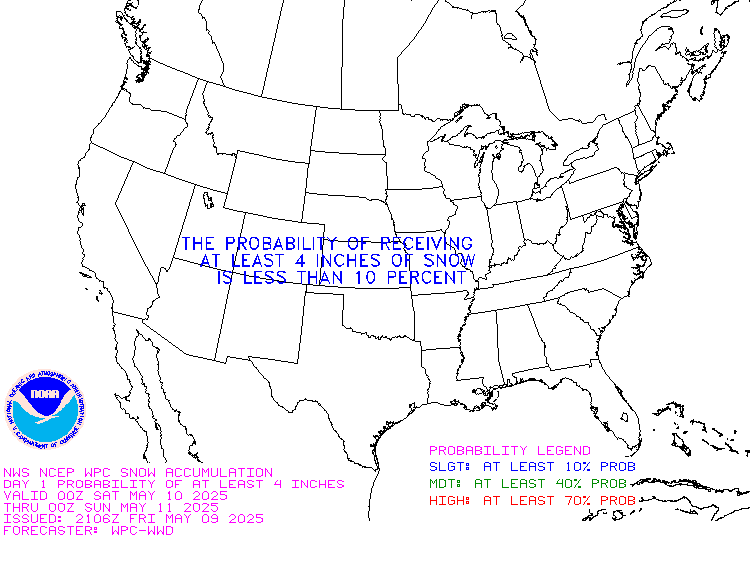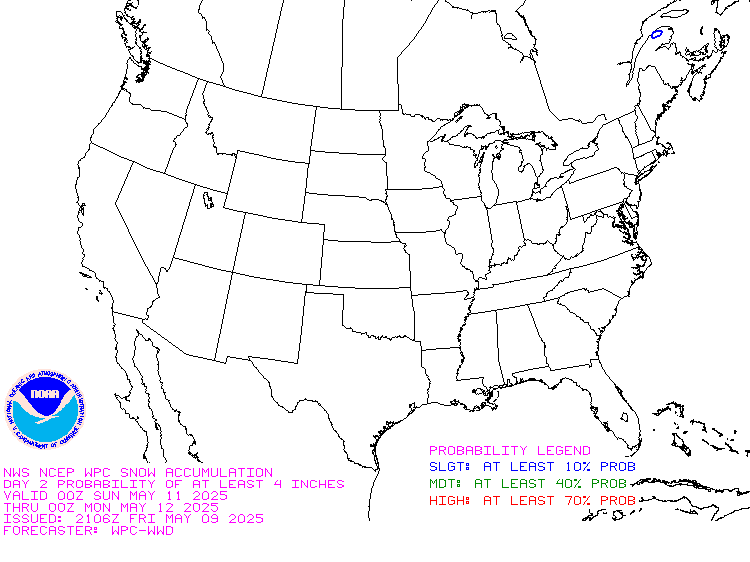This article focuses on what we are paying attention to in the next 48 to 72 hours. The article also includes weather maps for longer-term U.S. outlooks and a six-day World weather outlook which can be very useful for travelers.
First the highlights from the NWS.
Short Range Forecast Discussion
NWS Weather Prediction Center College Park MD
Thu Jan 04 2024
Valid 12Z Thu Jan 04 2024 – 12Z Sat Jan 06 2024…Snow expected for portions of the Four Corners region and adjacent High
Plains Thursday……Showers and thunderstorms with some locally heavy rainfall forecast
from Texas late Thursday into the Southeast Friday with storm system
traversing the Gulf Coast……Series of Pacific storm systems will keep low-elevation/coastal rain,
interior wintry mix, and high elevation mountain snow in the forecast for
the Pacific Northwest, Northern Rockies, and Great Basin…
Please click on “Read More” below to access the full report issued today.
| Notices: The article on the Updated Outlook for January 2924 can be accessed HERE. What would you like to learn about? Please provide that to me via the comment section at the end of the article. |
Now more detail on the 48-Hour Forecast (It is a 48 to 72 Hour Forecast actually)
Daily weather maps. The Day 1 map updates twice a day and the Day 2 and 3 maps update only once a day. These maps update automatically. But if that does not happen, you can get updates by clicking HERE
TODAY (or late in the day the evening/overnight map will appear) (Key to surface fronts shown on maps and you will then also be able to insert a city name or zip code and get a local NWS forecast).
TOMORROW
NEXT DAY
This animation shows how things may play out over the next 60 hours. To update click here.
The NWS Climate Prediction Center’s: Watches, Warnings, and Advisories plus other information can be found HERE. We post at least one of those updates daily, sometimes both. The Highlights are shown in the lede paragraph of this article.
ATMOSPHERIC RIVERS
This tells us what is approaching the West Coast. Click HERE to update If I have not gotten around to doing the update. Here is some useful information about Atmospheric Rivers.
Continuation of the NWS Short Range Forecast. It is updated by NWS twice a day and these updates can be found here
An active weather pattern looks to continue for the foreseeable futures as
a series of systems follow an energetic jet stream eastward from the West
Coast through the South and up the East Coast. An upper-level
trough/surface low pressure system currently passing through the Four
Corners region Thursday morning will move eastward towards the Southern
Plains through the day, encouraging moist Gulf return flow northward ahead
of the system which will contribute to areas of snow and a wintry mix in
the cooler air along and to the north of the surface low track. Moderate
to heavy snow will continue for higher elevations of the San Juan and
Sangre de Cristo Mountains of southern Colorado/northern New Mexico, with
accumulations of around 5-10″, locally higher, anticipated. Snowfall will
also begin for lower elevations east of the mountains along the Central
and Southern High Plains by Thursday afternoon. Snowfall totals generally
between 2-4″ are expected for portions of northeastern New Mexico,
southeastern Colorado, southwestern Kansas, and the western Texas and
Oklahoma Panhandles. Adjacent areas of Kansas and northern Oklahoma will
likely see a wintry mix of rain and some snow, with some light
accumulations possible.Showers and thunderstorms will begin in the warm air southeast of the low
track across Texas and into southern Oklahoma late Thursday afternoon and
into Thursday night. As the upper-level trough approaches the western Gulf
of Mexico, a second area of low pressure will develop, organizing and
strengthening into the primary surface low pressure/frontal system and
traversing eastward just to the south of the Gulf Coast. Further enhanced
southerly, moist flow overrunning a frontal boundary along the Gulf Coast
will lead to more widespread shower and thunderstorms producing moderate
to locally heavy rainfall, from the western Gulf overnight Thursday and
along the central Gulf Coast and into the Southeast Friday. Some isolated
instances of flash flooding will be possible. The low pressure system will
continue northeastward up the East Coast with rainfall and winter
weather-related impacts expected through the Carolinas, Mid-Atlantic, and
New England this weekend just beyond the current forecast period. Some
light freezing rain accumulations may begin as early as Saturday morning
along and just to the east of the southern Appalachians from northeast
Georgia through the Carolinas and into southwestern Virginia where warm,
moist air begins to override an area of shallow cold air damming along the
mountains.Upstream over the West, a Pacific storm system moving onshore the Pacific
Northwest Thursday morning will bring lower elevation/coastal rain, high
elevation mountain snow, and a wintry mix to interior valley locations
through the day. Precipitation will spread inland across portions of the
Great Basin and Northern Rockies as well. A second system will quickly
follow on the heels of the first late in the day Friday, bringing
additional precipitation chances and the potential for even heavier
snowfall in the Cascades. Any snow accumulations at lower elevations
should be limited, but the mountain ranges in the Great Basin and Northern
Rockies as well as southern portions of the Cascades can expect to see
between 4-8″, locally a foot, over the next couple of days. The northern
Cascades and Olympic Mountains could see as much as 1-2 feet.Elsewhere, some light snow showers are possible for the Interior Northeast
Thursday following a frontal passage. Enough moisture will be in place for
some light to moderate snow showers with a clipper-like low pressure
system dropping southeastward from Canada into the Northern Plains and the
Upper Midwest/Great Lakes Friday afternoon. High temperatures continue to
be running a bit below average from California eastward along the southern
half of the county as the active storm pattern and repeated frontal
passages keep temperatures down. Although we are fully into Winter,
portions of the Southeast/Florida and Desert Southwest will remain
relatively cool by local standards with highs generally in the 50s. In
contrast, highs will be above average along the northern tier of the
country generally away from the active weather.
Learn about wave patterns HERE.
Below is the current five-day cumulative forecast of precipitation (Updates can be found HERE)
Ski SnowReports
New Feature – Ski Reports. It is difficult to find reports that auto-update on-screen (and they are very long) but these links will get you to them – If you have additional suggestions make them in the comments section after every Econcurrents Article and we may add those links. We will try to not have too much overlap as that can add to the confusion.
Snow Forecasts. And remember this shows natural snow. Ski resorts also make their own snow.
Day 1

Day 2

Additional snow information can be found here and here. The second link provides animations.
Now we look at Intermediate-Term “Outlook” maps for three time periods. Days 6 – 10, Days 8 – 14, and Weeks 3 and 4. An outlook differs from a forecast based on how NOAA uses these terms in that an “outlook” presents information as deviation from normal and the likelihood of these deviations.
Below are the links to obtain updates and additional information. They are particularly useful if you happen to be reading this article significantly later than when it was published. I always try to provide readers with the source of the information in my articles.
| Days 6 – 10 (shown in Row 1) | Days 8 – 14 (Shown in Row 2) | Weeks 3 and 4 (Shown in Row 3 but updates only on Fridays) |
| https://www.cpc.ncep.noaa. gov/products/predictions/610day/ | https://www.cpc.ncep .noaa.gov/products/predictions/814day/ | https://www.cpc.ncep.noaa.gov/products/predictions/WK34/ |
Showing the actual maps. They should now update automatically. The Week 3 – 4 Outlook only updates on Fridays. So below is what I call the Intermediate-term outlook. On Fridays, it extends out 28 Days. That declines day by day so on Thursday it only looks out 22 days until the next day when the Week 3 – 4 Outlook is updated and this extends the outlook by one additional week.
| 6–
10
|
|
|
| 8–
14 |
|
|
| 3–
4 |
|
|
HAZARDS OUTLOOKS
Click here for the latest complete Day 3 -7 Hazards forecast which updates only on weekdays. Once a week probably Monday or Tuesday I will update the images. I provided the link for readers to get daily updates on weekdays. Use your own judgment to decide if you need to update these images. I update almost all the images Friday Night for the weekend edition of this Weather Report. So normally readers do not need to update these images but if the weather is changing quickly you may want to.
Temperature month to date can be found at https://hprcc.unl.edu/products/maps/acis/MonthTDeptUS.png
Precipitation month to date can be found at https://hprcc.unl.edu/products/maps/acis /MonthPNormUS.png
World Forecast
Below are the Day 1 -3 and 4-6 forecasts for temperature and precipitation. Updates and much additional information can be obtained HERE
World Temperature Anomalies
World Accumulated Precipitation
This information is provided by the University of Maine. They draw upon many different sources. There is a lot of information available at the link provided. I have just provided two useful forecasts. There are probably over a hundred different forecasts available from this source.
Worldwide Tropical Forecast (This is a NOAA Product)
This graphic updates on Tuesdays) If it has not been updated, you can get the update by clicking here Readers will only have to do that if they are reading this article much later than the date of it being published.
Information on Tropical Storms can be found HERE. Western Pacific information can be found HERE.
–
| I hope you found this article interesting and useful. |
–
